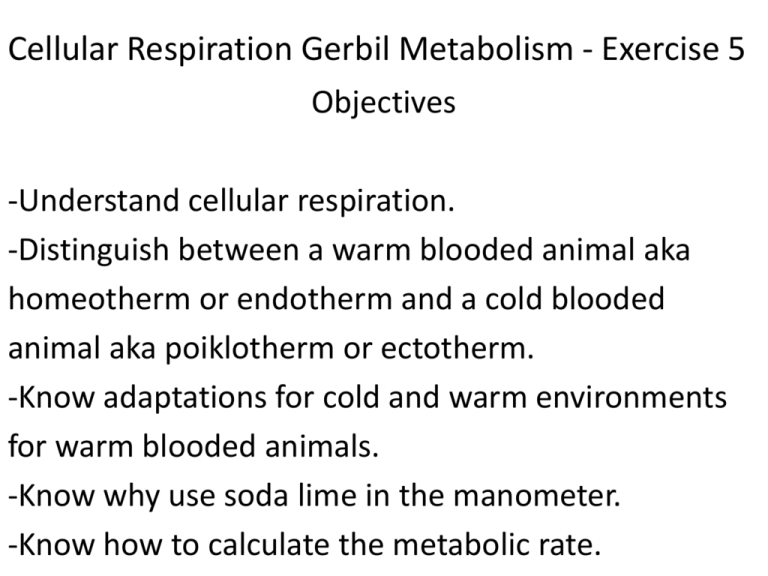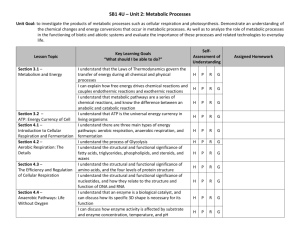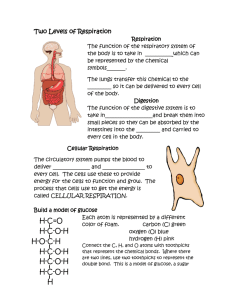Cellular Respiration Gerbil Metabolism
advertisement

Cellular Respiration Gerbil Metabolism - Exercise 5 Objectives -Understand cellular respiration. -Distinguish between a warm blooded animal aka homeotherm or endotherm and a cold blooded animal aka poiklotherm or ectotherm. -Know adaptations for cold and warm environments for warm blooded animals. -Know why use soda lime in the manometer. -Know how to calculate the metabolic rate. Cellular Respiration • Harvesting energy for cellular processes – Complex organic molecules (glucose) rich in potential energy simpler waste products with the release of energy C6H12O6 + 6O2 6CO2 + 6H2O + ENERGY (ATP+heat) • Respiration is a cumulative function of three metabolic stages • Glycolysis – Breaks down glucose into two molecules of pyruvate • The citric acid cycle – Completes the breakdown of glucose • Oxidative phosphorylation – Is driven by the electron transport chain – Generates ATP – Process occurs in the mitochondria ATP: adenosine triphosphate Oxidation of Organic Fuel Molecules During Cellular Respiration • During cellular respiration – Glucose is oxidized and oxygen is reduced • Cellular respiration – Oxidizes glucose in a series of steps Redox reactions: Transfer electrons from one reactant to another by oxidation and reduction In oxidation: A substance loses electrons, or is oxidized In reduction: A substance gains electrons, or is reduced becomes oxidized C6H12O6 + 6O2 6CO2 + 6H2O + Energy becomes reduced The energy of glucose is used as food (or fuel) by nearly all living organism, including plants and animals, to stay alive, to main homeostasis, and to run their metabolism. The energy stored in chemical bonds of food molecules must be released and converted into a diffusible, usable form. That form is the high energy molecules ATP. The release of energy from organic food molecules is accomplished by the chemical process of oxidation. Oxidation is the release of electrons and energy from a substance. Glucose is usually the food molecule that is oxidized, and the oxidation process involves a great many separate steps or chemical reactions. These reactions are collectively called cellular respiration. If a molecular oxygen is available to the cell, the cell will generate proceed to oxidize the pyruvate aerobically (oxygen required) until it has been converted to carbon dioxide and water. • In a container you have material that’s going to absorbed CO2 in water. If we didn’t have that couldn’t do measurements. As gerbil breaths takes O2 and gives off CO2. You wouldn’t see a change in volume of gases unless we get rid of CO2 in the water. • All the reactions in all of the phases of cellular respiration result in some energy being lost in the form of heat – i.e., an increase in entropy. • In most organisms, heat is simply dispense into the surroundings environment, but some organisms have evolved mechanisms to keep heat and maintain a constant temperature. • The heat is retained in part because of anatomical adaptations that reduce heat loss across the body surface. Some heat conserving adaptations include the evolution of fur, hair, feathers, and the deposition of fat near the body’s surface. These anatomical adaptations, along with a temperature detecting and regulation “thermostat” in the hypothalamus of the brain, enable certain animals to maintain a constant body temperature. Such animals are called homeotherm or endotherm these are birds, mammals, and the tuna fish species. All of the other animals are poiklotherms or ectotherm they are unable to maintain a constant internal body temperature. They cannot retain the heat that they produce, and their body temperature will fluctuate as the environmental temperature fluctuates. • Hemeothermic animals will regulate their product of heat (generate more when it is cold and less when it is hot) to maintain a constant body temperature despite fluctuations in the environmental temperature. Since the heat is produced from the chemical reactions of cellular respiration, the rate of cellular respiration is tried, in part, to thermoregulation (regulation of body temperature). • Effect of Varying Temperature on the Rate of Metabolism of a Homeothermic animal • The process of cellular respiration produces ATP energy which is needed to run an organism metabolic process. So we can measure cellular respiration of an organisms, one is, in effect, also measuring the metabolic rate of that organisms. The metabolic rate can be determines by measuring either the rate of consumption of the raw materials (glucose or oxygen) of respiration, or by measuring the rate of production of the end products (CO2 and water) or respiration. The easiest component to measure is oxygen consumption. • The animal is placed in a jar on a screen laying over a layer of soda lime. The soda lime will absorb carbon dioxide and water vapor; thus, they will not influence the gas pressure within the jar. The jar is sealed with a stopper connected to two ports. One leads to the outside air and the other port is connected to a pair of pipettes partially loaded with a colored fluid. The second pipette is open to the outside air. The fluid functions as manometer that will detect changes in pressure. The pressure on the fluid on the side of the open pipette will be constant (air pressure in the classroom does not change). The volume of oxygen consumed in any given time can be measured and extrapolated to an hourly rate. • The purpose of the laboratory experiment in today’s lab is to measure rate of cellular respiration (the metabolic rate) of gerbil at three different temperatures to see if there is a relationship between outside temperate and the metabolic rate of the gerbil. Experimental procedure • The gerbil in the container and weigh and record the total weight of the two together. Subtract the weight of the container form the total to obtain the weight of the gerbil. • You will test the animals at 3 temperatures: cold (5O), room (23O), and warm (35O) or vice versa. Calculation of Rate of Metabolism • The rate of cellular respiration can be used as an indirect measure of the rate of over all metabolism since metabolism is dependent upon the ATP generated by cellular respiration. • In order to compare the metabolic rates of animals of difference sizes (weights), it is necessary to convert the hourly average per animals to the average per unit weight. • The more energy gerbil consumes, the more oxygen he’s going to consume, the more CO2 he’s going to make. • All reactions in cellular respiration result in some energy being lost in the form of heat, and disrupted though out the environment. Anatomical adaptations, these new innovations reduce heat loss across the body, for example, fur, hair, feathers, these things are use for insulation. • a) Homeotherm (Endotherm): Warm blooded such as humans, birds, mammals. • b) Polklotherm (Ectotherm): Unable to maintain constant internal body temperature. Body temperatures will fluctuate as the environmental temperature fluctuates. • The rate of CR (metabolic rate) can be determine by measuring either the rate of consumption of raw materials (glucose or oxygen) or production of end products CO2 or water. • Smaller organisms have a higher Surface area to body weight ratio. • A larger organism has a lower surface area volume to body weight ratio. • If you want to keep temperature fixed, at cold temperature your going to burn a lot of energy to stay warm. As temperature goes up, the energy goes down. If temperature gets really high, he’s going to lower his/her body temperature. • During cellular respiration, the energy stored in the chemical bonds of food molecules is converted to the high energy molecules, ATP. Depending on the availability of oxygen, cellular respiration can take two paths. The anaerobic path (fermentation) does not require oxygen and yields little ATP. The aerobic path (citric acid cycle and electron transport chain) requires oxygen and yields much more ATP. Both paths start with glycolycis. • All of the reactions of cellular respiration also create heat. Aerobic cellular respiration in a homeotherm (gerbil). Homeotherms maintain a constant internal body temperature despite changes in the environment. One way that homeotherms maintain this constant temperature, is by adjusting their raters of cellular respiration - higher respiration rates create more heat. Because aerobic respiration requires oxygen, we will estimate aerobic respiration by measuring oxygen consumption. Energy comes from two process • 1. Fermentation: Glucose is broken down into enthol and CO2. Process only generates 2 ATP’s form of energy. • 2. Cellular respiration process that generates 36 ATP. Complete cellular oxidation of glucose molecules, requires oxygen. • Point: Trying to determine oxygen composition, then calculate the metabolic rate. Glucose Metabolism • Cellular respiration • C6H12O6 + 602 + 36 or 38 ADP’s + 36 or 38 P → 6CO2 + 6 H2O + 36 or 38 ATP’s • Glycolysis – Anaerobic cellular respiration • Transition step – Acetyl coenzyme A production • Krebs cycle – Energy transfer to coenzymes NAD+ and FAD • Electron transport chain – ATP produced – Aerobic cellular respiration Figure 23.26 Figure 23.25 • We need soda lime in the bottom that absorbs CO2, and salts. Otherwise experiment wouldn’t work. Page 73 – Lab Book Purpose • Measure CR of gerbil at three different temps and see relationship between outside temperature and metabolic rate of gerbil. • Difference of cage and gerbil in grams. • To compare metabolic rate of animals of different size (weigh) necessary to convert hourly average per animal temperature average per unit weight. Page 6 – Lab Book Page 74 – Lab Book • The smaller the animal, the higher metabolic rate and vice versa. • Get metabolic rate and don’t forget units mlO2/hr/g O2 consumption (ml) X 60 = mlO2/hr/g Minutes Page 75 – Lab Book Page 75 – Lab Book Which of these tables does not make sense with the rest of the data? Page 75 – Lab Book The one on the third row because when it gets to the 35 degrees Celsius its metabolic rate is increasing, and it should be decreasing. Page 9 – Lab Book Page 76 – Lab Book Summary of Cellular Respiration Questions 1. What was the name of the instrument that we used in the cellular respiration lab? 2. What did this instrument measure? 3. During the experiment, the fluid moved (towards/away from) the gerbil because of changes in _________ pressure as the animal respired. 4. An organism whose body temperature changes with the outside environment is called an _________ Its metabolic rate (increase/decreases) as temperature increases. 5. An organism who is able to maintain a stable internal body temperature regardless of the environmental temperature is called an _________ It’s metabolic rate (increases/decreases) as temperature increases. Questions 1. What was the name of the instrument that we used in the cellular respiration lab? Manometer 2. What did this instrument measure? Amount of oxygen consumed 3. During the experiment, the fluid moved (towards/away from) the gerbil because of changes in gas or air pressure as the animal respired. 4. An organism whose body temperature changes with the outside environment is called an ectotherm or poikilotherm Its metabolic rate (increase/decreases) as temperature increases. 5. An organism who is able to maintain a stable internal body temperature regardless of the environmental temperature is called an endotherm or homeotherm It’s metabolic rate (increases/decreases) as temperature increases. Questions 6. Which of the following is homoeothermic? a. b. c. d. e. Fish Reptiles Grass hopper Chicken Paramecium 7. In the experiment you did on cellular respiration, the soda lime in the gerbil’s jar: a. b. c. d. e. Provided oxygen for the gerbil. Absorbed oxygen given off by the gerbil Absorbed CO2 given off by the gerbil. Provided CO2 to the gerbil. Absorbed moister to keep the gerbil dry. Questions 6. Which of the following is homoeothermic? a. b. c. d. e. Fish Reptiles Grass hopper Chicken Paramecium 7. In the experiment you did on cellular respiration, the soda lime in the gerbil’s jar: a. b. c. d. e. Provided oxygen for the gerbil. Absorbed oxygen given off by the gerbil Absorbed CO2 given off by the gerbil. Provided CO2 to the gerbil. Absorbed moister to keep the gerbil dry. Questions 8. In the experiment, you determined metabolic rate by measuring: a. b. c. d. Oxygen production by the gerbil The body temperature of the gerbil Oxygen consumption of the gerbil The rate at which the gerbil moved. 9. What is the relationship between the body size and metabolic rate? 10.What is fermentation? What is the advantage of fermentation? What is the disadvantage of it? Questions 8. In the experiment, you determined metabolic rate by measuring: a. b. c. d. Oxygen production by the gerbil The body temperature of the gerbil Oxygen consumption of the gerbil The rate at which the gerbil moved. 9. What is the relationship between the body size and metabolic rate? The bigger you are, the slower your metabolic rate will be and vice versa. 10. What is fermentation? What is the advantage of fermentation? What is the disadvantage of it? Ethanol + CO2 are produced by fermentation & no oxygen is required. Questions 11.Calculate the metabolic rate of a gerbil that weights 120 g and consumes 4.2 ml of oxygen in 6 minutes. 12.Calculate the metabolic rate of a gerbil that weights 100 gm and consumes 2 ml of oxygen in 3 minutes. 13.A 50 gram gerbil who consumes 5 mL of oxygen in 3 minutes would have a metabolic rate of? Questions 11. Calculate the metabolic rate of a gerbil that weights 120 g and consumes 4.2 ml of oxygen in 6 minutes. 4.2/6 x 60 = 42 42/120 .35 ml/hr/g 12. Calculate the metabolic rate of a gerbil that weights 100 gm and consumes 2 ml of oxygen in 3 minutes. 2/3 x 60 = 40 40/100 .4 ml/hr/g 13. A 50 gram gerbil who consumes 5 mL of oxygen in 3 minutes would have a metabolic rate of? 5/3 x 60 = 100 100/50 2 ml/hr/g






